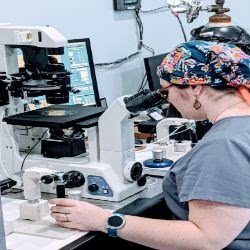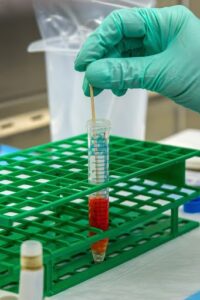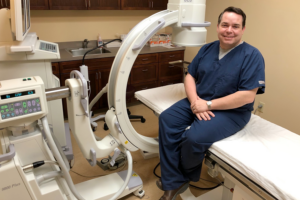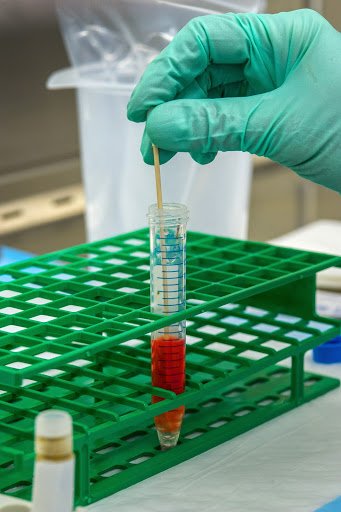 Dr. Travis McCoy, MD Reproductive Endocrinologist Advanced Gynecologic Surgery
Dr. Travis McCoy, MD Reproductive Endocrinologist Advanced Gynecologic Surgery
What is the role of testing after a failed IVF cycle?
It’s always disappointing and stressful when an IVF cycle fails. There are a number of reasons why a failed IVF transfer fails to be successful. Many of those include issues with the embryos and even those are less likely in a genetically normal embryo there can still be embryo issues responsible. However, when failures have been incurred it raises questions about the uterus and other factors. These uterine factors are not always easy to establish ahead of time, but when failures occur we try to take a step back and consider the possibility of other issues with the uterus.
And what would those issues be?
In the past, we’ve always attributed the issues solely to an embryo issue, but in the past, five to eight years we’ve realized there are other factors involved. Some of which we’ve had testing to search for and some are not understood. In some people there can be issues with the uterus itself and this is more common in a woman that has not had a pregnancy so her history comes into play if there had been a prior successful pregnancy then there are some things we don’t consider to likely be a problem. There are other things that can change as a woman gets older as well, there’s been a lot of research into these factors in the last five years. Our testing really looks at 3 other variables that can come into play.
Statistically, the most likely issue we see is undiagnosed or residual endometriosis on implantation success. Years ago we thought IVF fully overcame endometriosis but in the years since we’ve realized there can still be issues with the effect on the uterus and offering the uterus ability to allow an embryo to implant.
Why is endometriosis so important in this process?
In the past endometriosis was thought to be outside the uterus, but we’ve come to understand due to inflammation and other factors it actually alters the endometrium as well. We often start to look and reconsider the reason we went to IVF. A lot of unexplained infertility was mild endometriosis and so sometimes that goes along with why we went to IVF in the first place. There are tests we can do that are performed on the lining of the uterus which is called an endometrial biopsy. One of these first tests is called a Receptiva and this test looks for a marker in inflammation when that marker is there this reliably confirms in most cases the presence of underlying endometriosis and when this marker is present it can be related to a diminished implantation rate of embryos.
Are there treatment options for these patients?
Yes, they can be treated with certain types of hormonal suppression or in some cases surgery to correct the problem.

Well, IVF overcomes a lot of the problems with endometriosis affecting natural fertility, but in some cases, there can still be a residual effect on the uterus and so this testing can help determine if there are residual effects on the uterus. It does not mean that embryo implantation would not work, but the odds could be lower by the presence of it. So in some cases even if I know there are underlying issues if we have several embryos to work with we may still go ahead and attempt a transfer as a first step. If they have failed then often this is something that should be treated and that treatment process whether through hormonal correction or a surgical correction does take a few months to fully correct. On average, it takes about three months of treatment, but we think that these treatment options do mostly restore the implantation ability of the uterus.
Is this circumstance dependent upon age?
This is extremely common because endometriosis affects upwards of 50-70% of our fertility population in general. When there has been an abnormality or failure in testing is by far the most common. The tests available are most likely for endometriosis but it also detects Adenomyosis which is more common with advancing age and can have similar impacts on lowering implantation rates.
Additional testing that we do is newer with a test called an Emma-Alice test which is a test of the endometrium that looks for genetic markers of different types of bacteria that can be harbored in the uterus. Sometimes abnormal bacteria in the uterus can be detrimental to the endometrium working properly and also there is evidence that there are good bacteria that need to be within the uterus as well. This test looks for genetic markers showing the presence or absence of both good and bad bacteria.
These can be treated with target antibiotics based on the type of bad bacteria or using vaginal probiotics to help replace the healthy good bacteria. We used to think the uterus was a sterile environment, but we have since learned that it’s not. The uterus does better when there are good bacteria present, but the bad bacteria from the vagina up to the uterus interfere with the ability to get pregnant. These are easily treated. There is a third test, but probably the least likely to be abnormal is the ERA (endometrial receptivity analysis). The ERA is more helpful in a woman that has never conceived. It looks at the timing of what is best for that patient when to transfer an embryo back into her uterus in relation to progesterone exposure.
Is there a specific timetable for this?
The standard timing of when to do an embryo transfer is based on studies that show what worked best for the majority of patients. However, in some patients, their uterus needs to be exposed to progesterone for slightly longer, or slightly shorter time frames prior to putting the embryo back inside. The ERA helps show a window of receptivity.

Yes, it can be shifted slightly by one or even two days. Sometimes we have to transfer an embryo one to two days later than we normally would. What works for the majority of women does not work for every individual person. It’s about trying to capture a more personalized treatment for these women. We think this is an issue that likely doesn’t change throughout this specific patient’s life so who has conceived before it is less likely to be an issue.
At the end of a woman’s reproductive years is endometriosis only cured via a hysterectomy?
It all depends upon the symptoms. Some women have clear symptoms of endometriosis that we may not even do the ERA testing because it’s so blatantly clear it is present. The ERA test helps pick up the ones that are asymptomatic; they only show up regarding fertility issues which are really common. So of these tests in the order of the likelihood of being abnormal and likely helpful, it would be the Receptiva then the Emma-Alice followed by the ERA.
Our philosophy is that any person that has been successful really needs to consider these other possibilities rather than just having them go through repeated embryo transfers because embryos are in limited supply so we try and make sure we have investigated what needs to be done ahead of time before using those embryos.

If these patients have been unsuccessful with multiple embryo implantation attempts what are the options?
Mostly, endometriosis affects the natural environment that allows a natural conception. Some patients can have a residual effect that affects the IVF outcome. The endometrial issues and the progesterone exposure issue that ERA picks up is likely going to be an issue in the future despite previous pregnancies, whereas the bacterial issue is very transient and won’t need to be treated again.

Does insurance cover this type of testing?
Most insurance companies do not cover these tests. The Receptiva and the Emma-Alice can be done during her natural cycle which makes that testing much simpler. The ERA has to be done in a controlled cycle just like you were going to perform an embryo transfer. Because insurance doesn’t often cover this we don’t start with it before doing embryo transfers, but in a situation of a limited number of embryos, it is likely going to be more cost-effective before doing any embryo transfer.




 Dr. Travis McCoy, MD Reproductive Endocrinologist Advanced Gynecologic Surgery
Dr. Travis McCoy, MD Reproductive Endocrinologist Advanced Gynecologic Surgery